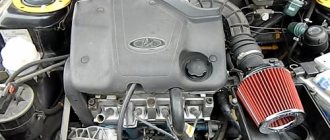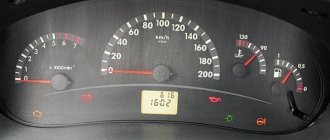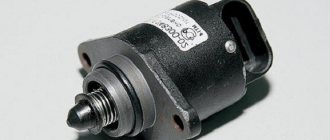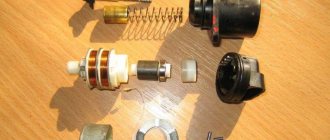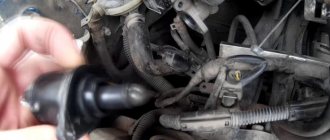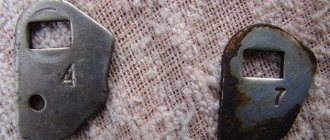Stopping or unstable idle speed
The first signs of a carburetor malfunction may be the engine turning off immediately after starting or unstable operation at idle speed. The causes of these problems are:
Clogged fuel nozzle channels XX . To fix this problem, you need to remove the nozzle, disassemble it and blow out the channel from the end with compressed air.
Malfunction of the EPHH control system or electromagnetic jet (malfunction of the VAZ-2107 carburetor). In this case, you should check the power supply to the valve from the control unit using a test lamp. The performance of the valve itself can be checked using a tester.
Violation of the tightness of the float mechanism. In this case, the specified fuel level in the chamber is not maintained. As a rule, gasoline overflow occurs. To eliminate the malfunction, you must first replace the needle along with the seat, and then adjust the required fuel level.
Insufficient clearance at breaker contacts. A sign of this may be unstable speed due to strong sparking of the contacts or a poor-quality spark. To eliminate the malfunction, it is necessary to adjust the contact gap (0.4 mm) and check that there is no play in the bearing.
Failure of the resistor , which is built into the distributor runner, can lead to poor spark quality. In this case, you will have to replace the resistor. If a breakdown occurs on the way and you need to continue moving, you can temporarily repair the open circuit with a thin wire, wrapping it around a resistor .
Wear or large play of bearing 800706U in a distributor with a vacuum corrector can be determined by an unstable spark. The damage can be eliminated by replacing the bearing.
Air leaks into the intake pipe can be the result of the following problems:
violation of the tightness of the hose or the vacuum brake booster system itself;
burnout of the head gasket or failure of the pipe connection;
wear or deformation of the crankcase ventilation system spool, which is located on the axis of the first chamber;
failure of the drainage tube;
coking of the annular slot zone of the quantity screw and sprayer.
The car accelerates poorly or with dips
If the engine speed in idling mode is stable, but the car has dips or picks up speed rather slowly, malfunctions of the VAZ-2109 carburetor can be caused by the following problems:
the fuel level in the float chamber is low;
insufficient fuel injection due to improper operation of the accelerator pump;
sticking of the centrifugal regulator of the ignition system interrupter-distributor;
the dimensions of the nozzles or air and main fuel jets do not correspond to the specified parameters;
clogging of the channels of the quality and quantity jets;
plaque on the emulsion tube of the primary chamber due to water ingress;
suction in the intake manifold or mismatch of the XX jet, which is typical after installation of a gas installation;
malfunction of the coil, slider, resistor, spark plugs or broken wire.
FakeHeader
Comments 8
Candles with a whitish coating are a poor mixture, the skirt is black? What can happen to the engine if you drive on a lean mixture? Or is it a little depleted?! Could the lean mixture be due to the ignition?! Or is it just because of the carburetor?! With whitish spark plugs, the engine runs well and the dynamics are good! What should I do or leave it like this?! I read in the manual that when you turn off the engine there should be no shaking, shaking is a late ignition! So it shakes as it is considered when, after turning off the ignition, it wobbles, still continues to work, or just turned it off and the engine staggered when stopped?!
Please tell me, I read it in the manual! Now we connect our light bulb with one wire to the positive terminal of the ignition coil, and the second wire to ground. We remove the central wire of the coil from the distributor cover and fix it at a distance of approximately 1-5 mm from ground. This is done in order to prevent breakdown of the ignition coil to ground. What if you just pull the wire out from there and from there?! Do you have to do it as written?!
Most likely a lean mixture. the spark plug should be brown, but there is a ringing noise, either early ignition, knocking piston pins like mine, or detonation))
Do not get into the carburetor under any circumstances - it works great with spark plugs. and do the ignition later - when you are driving in fourth, there should be no ringing when accelerating hard. and memz likes late ignition - a little - a little.
First, check the level in the float chamber. Second, put cooler candles. third, it’s not the valves that are ringing, but the piston pins. Fourth, the gasoline may be bad. Fifth, don’t break the car and it will never let you down.
how are these colder candles?, this is the first time I’ve heard
lean mixture. ringing, most likely detonation. The color of the insulator should usually be “coffee with milk”. for the first chamber, increase the fuel and reduce the air; the second is similar, only reduce the air even more
Basic faults
In order to make adjustments, you need to know several typical faults. Since this unit is responsible for dynamic characteristics, breakdowns include:
- Problems starting the engine, engine sneezing.
- Jerks, jerking, frequent failures on the accelerator pedal.
- Lack of overclocking options.
- Increased fuel consumption.
So, if while operating your car you were able to detect one or more faults from this list, then the part needs repair.
You need to know that the maximum adjustment of the DAAZ 2107 1107010 carburetor is possible only with the unit removed. The process does not involve cleaning this device with lint or woolen rags. You also won’t need any wires to clean the jets.
When making adjustments yourself, you must first remove the cover from the assembly. Then you can proceed to adjusting the float chamber. It's comfortable.
Why there is black soot on the spark plugs: reasons
Black carbon deposits on spark plugs may cover all spark-producing elements or appear only on some of them. If one element turns black, this can be associated with its malfunction. Sometimes the wire in the spark plug just burns out. But a malfunction of the cylinder corresponding to this element cannot be ruled out.
If the element is covered with soot on only one side, this indicates a poor valve fit. Also, the reasons may be a burnt-out valve or problems with the timing belt.
Uneven formation of soot is caused by a mismatch between the heat rating of the spark plug and the type of engine. If the CN of an element exceeds the established norm, only its upper part will become dark, and the body will remain white. With a low heat number, on the contrary, the color of the body will change.
When all the elements turn black at once, this is a consequence of late ignition. In this case, it is recommended to listen to the starter. If the ignition is really late, the starter makes sounds similar to knocking.
Also check the operation of the injector. If it malfunctions, the TV mixture may become excessively rich. As a result of the combustion of such fuel, a black coating is obtained. Its appearance is also associated with the following malfunctions:
- clogged air filter;
- incorrect ignition angle;
- damage to wiring insulation;
- deformation of the distributor runner or its cover;
- ignition coil defect.
Let us summarize the reasons for the appearance of carbon deposits on different types of engines.
Carburetor
Here, the formation of soot is usually associated with excessive enrichment with fuel. Unburned fuel can settle on the spark-forming elements installed on carburetor engines due to malfunctions of the carburetor or its incorrect settings.
Often problems arise due to a malfunction of the electric valve or insufficient compression in the cylinders. In this case, check the air filter, since on carburetor engines it becomes dirty somewhat faster than on injectors.
Another common cause is insufficient sparking.
Injector
Black deposits in injection units are usually formed due to increased pressure in the fuel frame. The fuel is supplied too actively and does not have time to burn out. The operation of the pressure stabilizer is disrupted.
Look at the ignition coil - it has probably failed due to an incorrect timing.
A common cause is wear on the condenser or piston rings. And finally, the spark-producing elements themselves can also break.
Extreme conditions of spark plugs
Metal dust, oil, gasoline
The presence of oil, drops of gasoline and small metal fractions on the electrodes is an indication that the cylinder is not functioning. The culprit is either a damaged valve or broken partitions between the piston rings. Parallel symptoms:
- Constant tripping of the engine.
- Significant loss of power.
- Double increase in appetite.
Destruction of the central electrode with a ceramic insulator
Prolonged operation in detonation mode and low octane fuel are the key causes of the crash. However, one should not write off defects in the manufacture of the product and incorrect operation of the mixture ignition system. At the same time, the engine runs rough, eats a lot and delivers power poorly.
How to adjust the mixture on an injection engine
The carburetor is used to mix fuel with air and then deliver the resulting mixture to the car engine, where it burns and creates pressure on the valves of the engine block. The resulting force causes the car to move, pick up and slow down
Carburetors are still used on older models of cars, trucks, small airplanes, and motor boats.
Causes of black soot
Before finding out the reason why the candles turned black, it is important to understand how this happened, how many of them turned black (one, two or all at once), on which side the soot formed (on one, two or all around), how “dry” it is. or "wet".
This determines how to diagnose and what to pay attention to first.
It is also important to understand that some malfunctions contribute to the rapid formation of black soot and affect its character, and some chronic engine problems can change the condition of the spark plugs gradually.
But before you indulge in various breakdowns, make sure:
- Is the idle speed set correctly, especially for carburetor engines?
- Are you driving the car correctly, are you not overloading the engine with high speeds, what is the cruising speed on a flat road. Those. It is important to make sure that the machine was operated as correctly as possible and the spark plugs worked in their optimal mode.
- If the conditions listed in paragraph 2 are met, the appearance of the first slight deposit on new spark plugs will occur after 150 - 200 km. If earlier, and it is clearly black, then you should sound the alarm.
- Where do you refuel and what kind of fuel do you put in the tank? If you often drive on gasoline, then don’t be surprised by black spark plugs, but you won’t be able to really find out why they became that way. Also, in the cylinder, at a temperature of about 500 0 C, low-quality gasoline does not burn completely, which also causes black soot on the spark plugs.
- Late ignition - uniform black carbon deposits form on the spark plug.
- Malfunctions in the ignition system (carburetor engine). The following malfunctions can lead to incomplete combustion of fuel in the cylinders as a result of a weak spark or to failures in its formation and, as a result, the appearance of black soot, these are: faulty ignition coil and spark plugs themselves, poor insulation of high-voltage wires, ignition angle is set incorrectly, breakdown of the distributor runner and the cover itself.
- Valve burnout. Carbon deposits can form on both the side and bottom electrodes, i.e. from a certain side. Also, incorrectly adjusted thermal valve clearances can lead to incomplete combustion of fuel in the cylinders and, as a result, the appearance of carbon deposits on the spark plugs.
- Enriched air-fuel mixture. This case is characterized by a black velvety soot without oil stains.
Applies to both carburetor and injection engines. As for the first, the formation of black carbon deposits on the spark plugs can be influenced by: the float touching the chamber walls or its depressurization, incorrect fuel level in the carburetor, a strongly protruding fuel pump drive pusher, which creates high fuel pressure in the system, or a depressurized needle valve. As for the injector, pay attention to the condition of the injectors, which, as a result of depressurization, can constantly flood the spark plugs with fuel. And also on the MAF (mass fuel flow sensor). It analyzes the mixture and sends data to the ECU. If it is faulty, the ECU will give incorrect commands to the injectors. - Incorrect heat rating. One of the criteria for choosing spark plugs is the heat rating. The higher it is, the less the candle heats up and vice versa. A spark plug with an incorrectly selected heat rating for a particular engine may not only blacken unevenly, but also fail.
- Low compression. In the cylinder where the black spark plug was found, check the compression.
- The power mode economizer ball valve (for carburetors) has failed. As a result of this malfunction, a large amount of fuel enters the cylinders even when it is not needed, for example, during normal engine operating conditions.
- High pressure in the fuel rail (for injectors). Fuel regulator is broken.
- The air damper actuator and air filter have failed. Check the latter and replace if necessary.
- Notice the smoke coming from the exhaust pipe.
If the engine is running on a rich fuel mixture or late ignition is observed, this will manifest itself:
- High level of engine vibration as a result of its unstable operation, especially at low speeds.
- The appearance of error P0300 on the instrument panel of an injection car and misfires on the carburetor.
- Poor engine starting.
Carburetor quality screw VAZ 21083
So this means: the position of the quality screw depends on the fuel level
Does not depend. These are different things.
You already decide whether the level in the carburetor depends on the number of revolutions of the quality screw!
Hello Igor. Although the idle system takes fuel from the float chamber, the quality control almost does not feel this. (Checked with a gas analyzer). But the fuel level is strongly felt in operating modes. And especially at maximum loads. And the quality screw adjusts to XX, when the engine needs very little fuel.
You already decide whether the level in the carburetor depends on the number of revolutions of the quality screw!
Hello Igor. Although the idle system takes fuel from the float chamber, the quality control almost does not feel this. (Checked with a gas analyzer). But the fuel level is strongly felt in operating modes. And especially at maximum loads. And the quality screw adjusts to XX, when the engine needs very little fuel.
The client’s level is 2mm below normal and the screw is unscrewed 9 turns?
But Solex always has a lot to unscrew. I can’t even say how many revolutions I set, because I always set it with a gas analyzer. But it is better to unscrew more than less. If you tighten the quality screw too much, the car will become dull when starting and accelerating at low speeds. But this will not affect consumption, since the XX system does not work in operating modes.
The client’s level is 2mm below normal and the screw is unscrewed 9 turns?
But Solex always has a lot to unscrew. I can’t even say how many revolutions I set, because I always set it with a gas analyzer. But it is better to unscrew more than less. If you tighten the quality screw too much, the car will become dull when starting and accelerating at low speeds. But this will not affect consumption, since the XX system does not work in operating modes.
The client’s level is 2mm below normal and the screw is unscrewed 9 turns?
But Solex always has a lot to unscrew. I can’t even say how many revolutions I set, because I always set it with a gas analyzer. But it is better to unscrew more than less. If you tighten the quality screw too much, the car will become dull when starting and accelerating at low speeds. But this will not affect consumption, since the XX system does not work in operating modes.
I don’t know, I always focus this way up to five turns, the level is normal, if you open it more, you add it! If it works on a twisted one, then you open it, it definitely overflows!
Try unscrewing the solenoid valve a little and tightening the quality screw. And look at the reaction. Better yet, measure CO. It may even be possible to adjust the mixture to XX, but you will eat a lot.
What to do if soot appears
First of all, it is necessary to remember that oil contamination and overheating, which results in soot on the spark plugs, are very harmful to the ignition system . Overheating is especially dangerous, since it causes the possibility of failure of the electrodes on the spark plugs without the possibility of their restoration.
If your car only has one blackened spark plug, you can diagnose the breakdown by simply swapping the spark plugs. If after this the new spark plug also turns black and the old one clears up, it means that the problem is not in the spark plugs, but in the cylinder. And if nothing has changed, then questions arise about the performance of the candle itself.
Oil deposits
In some cases, the candles may be wet and black. Most often, the reason for this fact is oil getting into the combustion chamber. Additional symptoms of this problem are as follows:
- difficulty starting the engine;
- omissions in the operation of the corresponding cylinder;
- the engine jerks during operation;
- the appearance of blue smoke from the exhaust.
Oil can enter the combustion chamber in two ways - from below or from above. In the first case, it enters through the piston rings. And this is a very bad sign, because it often threatens a major engine overhaul . In rare cases, you can get by with decoking the engine. If oil enters the combustion chamber through the top, it comes from the cylinder head along the valve guides. The reason for this is the wear of the valve stem seals. To eliminate this problem, you only need to replace the caps.
Carbon deposits on the insulator
Red carbon deposits on a candle
In some cases, carbon deposits that naturally appear in the combustion chamber can come off the piston at high engine speeds and stick to the spark plug insulator. The consequence of this will be gaps in the operation of the corresponding cylinder. The engine will “trouble” in this case. This is the most harmless situation why spark plugs turn black. You can eliminate it simply by cleaning their surface or replacing it with new ones.
If black and red spark plugs , this means that you are pouring fuel with an excessive amount of metal additives. It cannot be used for a long time because over time, metal deposits form a conductive coating on the surface of the spark plug insulator. Sparking will deteriorate and the spark plug will soon fail.
Cleaning spark plugs
Flushing with removal from the engine and complete disassembly
Here we need the same tools and tools.
The order of work is as follows:
- We carry out the work provided for in paragraphs 1–12 from the previous chapter.
- Disconnect the air and throttle valve drive cables from the carburetor.
- Using a 13mm wrench, unscrew the nuts (4 pcs) securing the device to the engine.
- We disconnect the heating block from it by unscrewing the screw with a Phillips screwdriver.
- We unscrew the fuel quantity adjustment screw by hand.
- We do not remove the throttle valves.
- Using a slotted screwdriver, unscrew the fuel quality adjustment screw.
- Soak the carburetor body in kerosene (gasoline, acetone). After this, we clean it with a toothbrush.
Video: cleaning the Solex carburetor
After assembling the carburetor and installing it on the engine, it is necessary to adjust it.
Adjusting the carburetor on a VAZ-2106
All components of the car mechanism require careful care, regular maintenance and periodic preventive repairs. Prevention and maintenance consist of disassembling the housing, thoroughly cleaning and rinsing the internal and external surfaces of the parts.
After disassembling the carburetor, an external inspection of the parts is carried out and faulty components are rejected. You can start setting up only if all elements are in working order. After all defective components have been replaced and the carburetor assembly has been reassembled and installed, adjustments can begin.
Adjusting the float of the VAZ-2106 carburetor
The basis for setting up the unit is the adjustment of the float. Exceeding the standard filling level of the internal chamber leads to oversaturation of the fuel with oxygen and an increase in gasoline consumption without improving the dynamic characteristics of the car.
In terms of setting the float position, the adjustment of the 2106 carburetor is carried out in several stages:
- Removing and installing the top cover of the housing in a vertical position.
- Correction of the needle position, the result of which should be contact of the needle ball with the surface of the float.
- Control of the gap between the float and the cover, the adjusted gap should be 6 mm with a tolerance of +0.25 mm. A tool for eliminating excess or insufficient clearance is a float tongue, by pressing which the adjustment is made.
- Control of the float stroke, which in the adjusted state is 8 mm with a tolerance of +0.25 mm.
Adjusting valve clearances
Prevention and maintenance of the carburetor on the VAZ-2106 consists of disassembling the body, thoroughly cleaning and rinsing the internal and external surfaces of the parts
The gaps are checked on a cold engine using a 0.15 mm gauge. Based on the results of the inspection, the need to refine the gaps is determined.
Ignition timing setting
The ignition timing is set by aligning the control marks on the gas distributor cover and the flywheel.
Debugging the idle speed mode
This stage of work requires preliminary preparation of the mechanisms. It is required to warm up the car's power unit to 900°C, achieve starting and stabilize the engine by rotating the qualitative and quantitative fuel screws, if this does not happen automatically.
Adjusting the VAZ carburetor at idle speed:
- By rotating the screw, which regulates the quantitative characteristics of the fuel, set the crankshaft speed in the range of 800-900 rpm;
- By rotating the screw, which is responsible for the quality of the fuel, achieve stable and smooth operation of the power unit at the maximum possible number of revolutions;
- Reduce the speed by tightening the quantity screw to speed values in the range of 950-1030 rpm;
- Increase the rotation speed again to maximum by unscrewing the quality screw;
- Consistently repeat steps 2-4 until the number 950-1030 rpm coincides with the maximum number of revolutions achieved by rotating the quality screw;
- Having achieved a coincidence of indicators, return the quality screw to the position corresponding to the number of revolutions of 800-900 rpm.
Thorough cleaning
In severe cases, it will not be possible to clean the jets without removing the carb. Over time, debris accumulates in the carburetor chamber, causing the passages to become clogged and clogged.
Preparing for a thorough cleaning is called interfering with the position of the spark plug wires. Two armored wires are swapped (for example, the armored wire of cylinder 1 is placed in place of the wire of cylinder 4, and vice versa). The engine starts, with a terrible “shooting” and “sneezing” sound. This allows sediment to be automatically knocked out of the channels back into the chamber.
Is leakage of the second chamber of the Solex carburetor necessary or not?
Setting up the “overflow” of the Second Camera (Problem XX) More details
Installing/adjusting the SECOND CHAMBER CLEARANCE of the Solex carburetor. More details
And again the gaps of the second chamber?! How can?! More details
Leakage of chamber 2 is an unexpected confirmation of the sad forecast Read more
When the first chamber is LEAKING, watch CAREFULLY for leaks in the second! More details
About the “spillovers” of the second chamber (Experiment. Special issue) More details
DAAZ WARNING! The second Solex chamber MUST BREATHE!!! More details
ATTENTION! CONTEST!!! SOLEKS and 2nd camera!!!! More details
Gap of the second chamber, needed or not, tests of options. More details
Svetlov leakage 2 cameras Solex Read more
Poroshin leaks in chamber 2 of Solex adovnya for carburetor Video illustration Read more
RPM FLOATS at Idle! Digging into the First Chamber! More details
Dips when pressing gas (accelerator) More details
Cheboksary. 2109 for repairs. FUEL CONSUMPTION again! More details
It's pouring, it's sausage... Stubborn "SOLEX" Aw!!! Where are you even single???? More details
How does the spark plug gap affect idle speed? More details
ICE theory: How to set up a SOLEX carburetor (Part 1) More details
SOLEX System U/N An important point in eliminating failures Read more
Why do candles die or DO NOT LIGHT FOR A LONG TIME! Check your spark plugs often! More details
Source: https://putinizm.ru/peretechka-vtoroy-kamery-karbyuratora-soleks-nuzhna-ili-net
